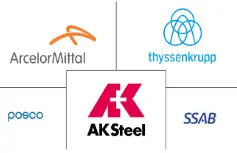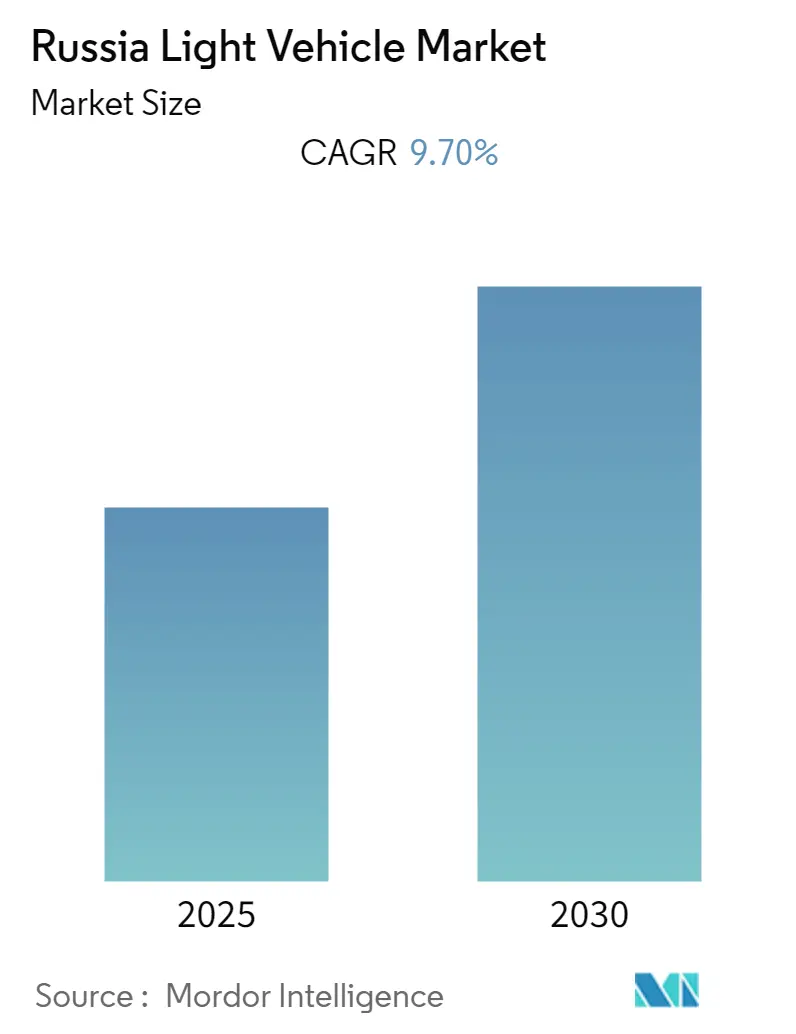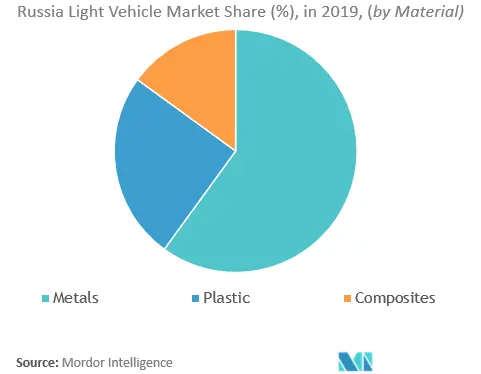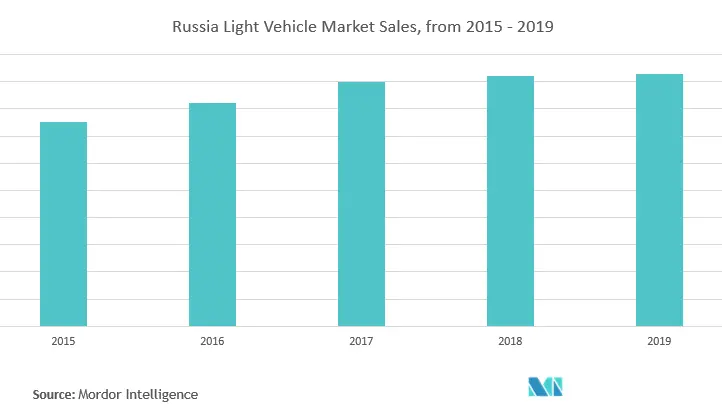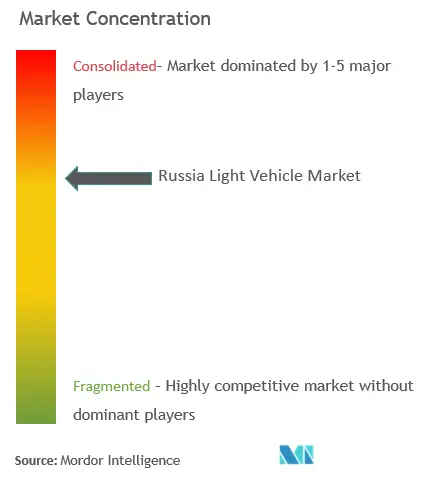Russia Light Vehicle Market Analysis
The Russia Light Vehicle Market is expected to register a CAGR of 9.7% during the forecast period.
Currently, the market for lightweight vehicles is primarily driven by regulatory authorities pushing for fuel-efficiency and increased demand from the developed economies of Russia for higher focus on reducing the cost of materials through concentrated research drive the growth of the Russia Light Vehicle Market.
The ideal materials for lightweight cars in this market include aluminium, high strength steel, and magnesium. With the enactment of stringent emission norms and fuel economy standards in the Russiaan region, the region's automobile manufacturers have started using carbon fiber composites in the manufacturing of their vehicles.
With the emergence of electric vehicles and an increasing ban on diesel vehicles' production of gasoline and diesel engines, the fossil fuel-run automotive industry's growth may face negative growth. However, lightweight car materials will remain a driving factor due to its application in an alternative fuel vehicle market.
Russia Light Vehicle Market Trends
Continuous Evolution in automotive AHSS technology
There is a demand for reducing the weight to enhance vehicle performance and safety. As a result, Advanced High Strength Steel (AHSS), an essential material for mass vehicle reduction, and has become one of the fastest-growing material in today's automotive industry.
Steel makes up around 70 % of an average automobile's weight. Compared to standard steel, AHSS enable to reduce vehicle weight by 23-35% which is around 165 to 250 kg, for a regular passenger car, saving 3 - 4.5 tons of greenhouse gases over the vehicle's total life cycle. This saving in emissions is much more substantial than the CO2 emitted during the complete production of steel needed in a car.
The steel composition involves 34% as the body structure, panels, doors, and trunk closures, giving it an energy absorption and high-strength in case of a crash. 23% is the engine and machinable carbon steel for the wear-resistant gears. 12% is used in the suspension, using rolled high-strength steel and the remainder in the wheels, tires, fuel tank, steering, and braking systems.
To produce higher strength for reduced steel section size and weight, automakers use less material, significantly reducing a vehicle's weight. The steel industry is focusing on developing different alloys for processing combinations, steel with high tensile strength and ductility, along with optimizes chemical compositions to achieve multiphase microstructures of AHSS.
Other advancements include the expanded capabilities to automotive steels that have high strength, which enable the design of thinner parts optimizing stiffness but maintaining geometries. AHSS such as Nano Steel helps deliver thinner gauges of steel and components to manufacture at room temperature.
In 2018, the technical partnership between Aston Martin and Dow has enabled the development towards AHSS and implementation of customized industry-leading solutions in light-weighting, powertrain efficiency, and vehicle electrification.
There is a Growing Demand for lightweight cars in Russia
Many Russian companies are experimenting with new composites that can reduce the vehicle's total weight to a great extent. The application of carbon-fiber-reinforced plastic (CFRP) has been widely adopted to produce automotive bodies. However, even in Russia, the high cost of materials like carbon fibre and AHSS, and the ongoing research on the material mix, the growth of this industry hasn't reached its full potential.
Russia is one of the largest manufacturers of lightweight vehicles. With the market for lightweight vehicles in development, various initiatives within Russia are driving the technological advancements. As per, government regulatory framework, there is a growing motivation for a low-carbon economy by 2050.
Russian carmakers such as LADA, Kia, Renault and Hyundai are working together to produce more efficient vehicles. Their goal is to reduce energy consumption by 10% and global warming potential (GWP) by 6% by reducing the vehicle's weight by 31 to 33% while maintaining the cost.
Manufacturers are working to reduce overall vehicle weight, which lowers the energy required to operate the vehicle and increasing fuel economy. The Body-In-White system is the critical focal point for automakers looking for fuel savings because of its weight reduction potential, importance to crash safety, and impact on compounded weight reduction for other sub-systems, such as the powertrain.
Russia Light Vehicle Industry Overview
The Russia Light Vehicle car market is moderately consolidated with existing players such as ThyssenKrupp AG, SSAB AB, POSCO, ArcelorMittal SA, Baoshan Iron & Steel Co. Ltd., AK Steel Holding Corporation. As the demand for light vehicles is growing in the region, the automotive manufacturers are trying to edge over its competitors by making joint-ventures, partnerships, and launching new products with advanced technology.
Russia Light Vehicle Market Leaders
-
Arcelor Mittal
-
SSAB
-
POSCO
-
AK STteel
-
Thyssenkrupp
- *Disclaimer: Major Players sorted in no particular order
Russia Light Vehicle Industry Segmentation
The Russia Light vehicle Market report covers the current and upcoming trends with recent technological developments in various market areas by vehicle, fuel and material type . The country-level analysis and market share of significant light vehicle manufacturing companies across Russia will be provided.
| Vehicle Type | Passenger Cars |
| Light Commercial Vehicles | |
| Fuel Type | Gasoline |
| Diesel | |
| Electric | |
| Material Type | Glass Fiber |
| Carbon Fiber | |
| High-strength Steel | |
| Others |
Russia Light Vehicle Market Research FAQs
What is the current Russia Light Vehicle Market size?
The Russia Light Vehicle Market is projected to register a CAGR of 9.7% during the forecast period (2025-2030)
Who are the key players in Russia Light Vehicle Market?
Arcelor Mittal, SSAB, POSCO, AK STteel and Thyssenkrupp are the major companies operating in the Russia Light Vehicle Market.
What years does this Russia Light Vehicle Market cover?
The report covers the Russia Light Vehicle Market historical market size for years: 2019, 2020, 2021, 2022, 2023 and 2024. The report also forecasts the Russia Light Vehicle Market size for years: 2025, 2026, 2027, 2028, 2029 and 2030.
Our Best Selling Reports
Russia Commercial Vehicle Industry Report
Statistics for the 2025 Russia Light Vehicle market share, size and revenue growth rate, created by Mordor Intelligence™ Industry Reports. Russia Light Vehicle analysis includes a market forecast outlook for 2025 to 2030 and historical overview. Get a sample of this industry analysis as a free report PDF download.

